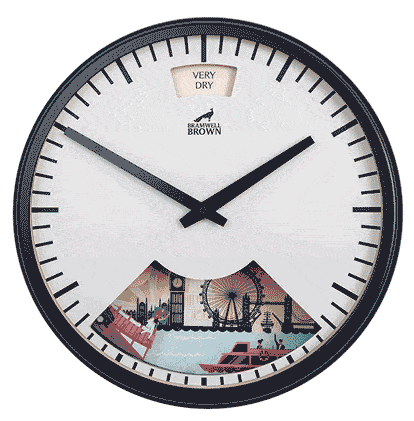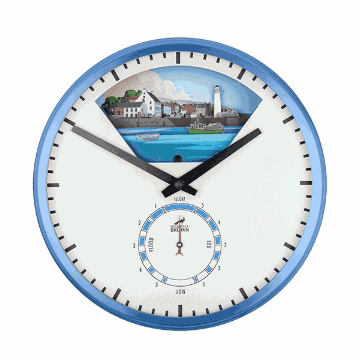The Bramwell Brown Blog
How to Hang a Heavy Wall Clock
You may have just gotten a gorgeous clock that you’re eager to hang, only to realise it’s no lightweight! You could be concerned with how to hang it without it falling and breaking or risking damage to the wall. There are a few ways that could work for you to hang your clock in the perfect spot, even if you’re limited with what you can do to the wall or don’t have much handyman experience. Our guide will take you through some key methods and ways to test the strength before putting up your hefty timepiece.
Keep in mind what kind of wall you’re hanging your clock on as not all methods will work for every type of wall. We’ll look at the best options for each wall, and the alternatives that are not recommended.

1. Nails and Screws
Nails are the tried-and-true method of hanging pretty much anything on your walls. You’ll want to gauge how much a nail can hold as you may need to use more than one. Screws are also a good option, especially if you’re putting it in wood where you experience a lot of expansion and contraction in climates with fluctuating temperatures. Make sure the nail or screw is strong enough to hold it and secured by tugging on it firmly.
Once you’ve installed it, consider hanging something about the same weight that isn’t as delicate as your clock (a string with a weight will work) and cushioning the floor below should it fall. This is a great way to test the hold strength over time to be sure that your clock will hang securely.
Nails and screws are great for wood, like the 2x4 that is behind the wall. You can find the optimal spot for hanging with a stud finder or magnet to find where the 2x4 runs. For dry wall, concrete and brick, you’re going to want to consider some of the options below instead.
2. Adhesive Hooks
You may want to consider adhesive hooks for anywhere that you can’t puncture the wall, like dorms and rentals. This works best where you have a flat surface and can clean it effectively with rubbing alcohol. Drywall and plaster walls are likely your best candidates for this, as brick and concrete may have too much texture for this to work effectively.
Get the weight of your clock and keep this number handy so you can pick the right hook for your clock, noting how much weight a single hook can hold. If you’re unsure, you may want to go with two hooks for the combined strength to hold up your clock, using a strong tensile wire if your clock has only one spot of attachment.
Mark the spot above where you’d like to hang your clock and clean the area with rubbing alcohol to ensure there are no contaminants that will prevent the adhesive from sealing. Apply the hook carefully and let it cure for the recommended time before hanging up your clock.
Recommending Reading: How to Hang a Wall Clock Without Nails
3. Anchors and Hooks
For walls that don’t have a lot of structure, like drywall, you may need to use something that adds a bit more strength. Anchors are usually cone-shaped, and come in plastic or metal. They are designed to fit into the wall either hammering them in or screwing it in before inserting the screw or nail itself.
The anchor serves to provide extra support and security by opening up on the back of a hollow-sided wall like drywalls and plasters so that there is more strength. There are a variety of them, some spiral in while others have slots that open up once inserted. Look at the packaging to see what fits your needs best.
Metal anchors will also work on brick and concrete walls, so they are quite versatile for hanging anything heavy. You may even consider this in addition to a regular screw or nail since there are many kinds that can fit into wood with the help of a hammer.
4. Picture Hanger and Hooks
If you’re looking to keep holes in the wall to a minimum, you might want to consider a picture hook or hanger. They come in a few varieties; the most popular being the slanted nail with an attached hook. This installs pretty quickly, with a hammer to the spot where you’d like to hang your picture. Ideally, you’ll want to find the 2x4 behind your wall to mount your clock, but it does work in drywall as well.
The MonkeyHook brand also carries a few options and works by sliding a half-heart-shaped hook into the wall, twisting it and having it become a bracer for itself on the hidden side of the wall. This has added strength and stability as the hook will use the weight of the clock to help support itself on the wall.
Recommending Reading: What is the Best Place to Put a Wall Clock
5. Brick Clips
This solution is specifically for hanging a clock on a brick wall. The ideal type of wall for this is one that isn’t painted and one that doesn’t have mortar sticking out to the very edge of the brick. However, there are also mortar clips that you might work if this is the case.
You’ll need to know the size of your brick in order to get a clip that fits. The clip is essentially a bit of metal that hangs on to the top and bottom of a single brick and has a hook formed at the front for you to hang your clock from. Be sure that the clip is rated for you to hang a heavy clock on, or consider using multiple clips and a strong wire.
While there are many ways to hang a heavy clock, in the end, the decision will come down to what type of wall you have and what restrictions and preference you have toward your wall. Be sure to test the strength of your hanger before hanging your clock. If you have a handheld luggage scale, that could be useful as well in testing how much the hanger can hold.
Regular-sized Bramwell Brown clocks are around 5kg when hung on the wall but still require a strong single screw wall fixing to keep them securely in place.






